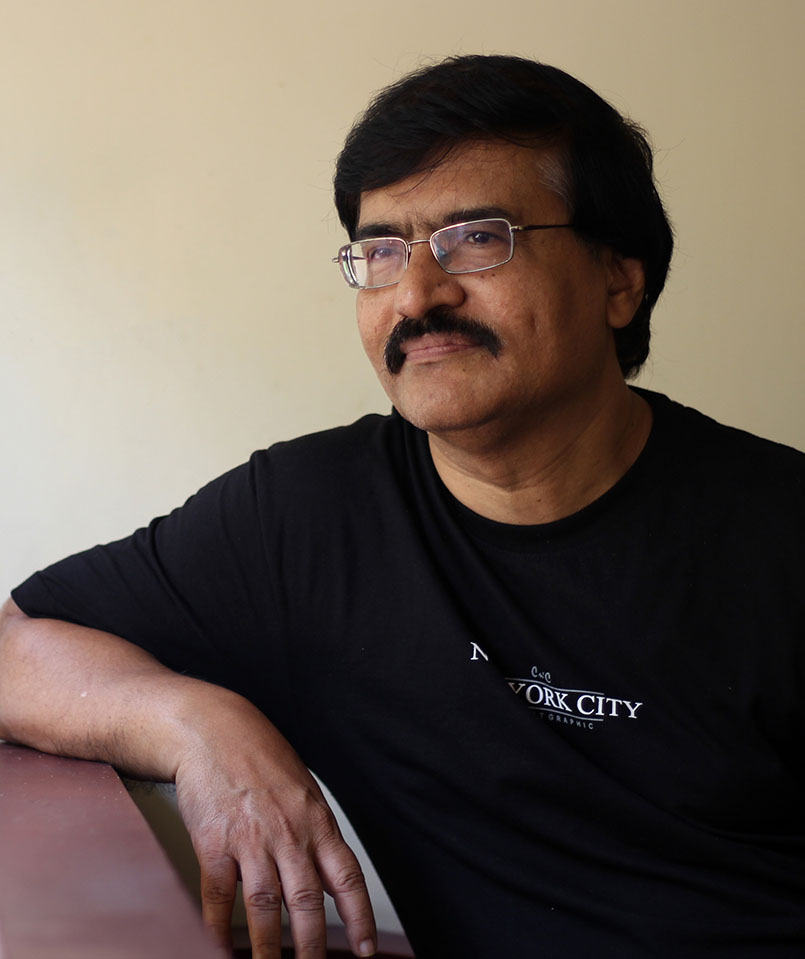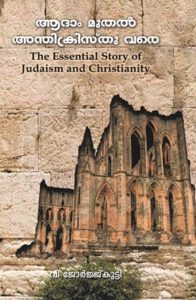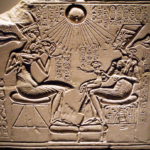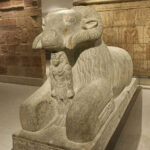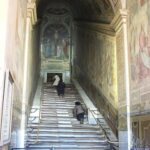“Their end is destruction, their god is their belly, and a token of the covenant. Their minds are set on earthly things.”
(Philippians 3:19).
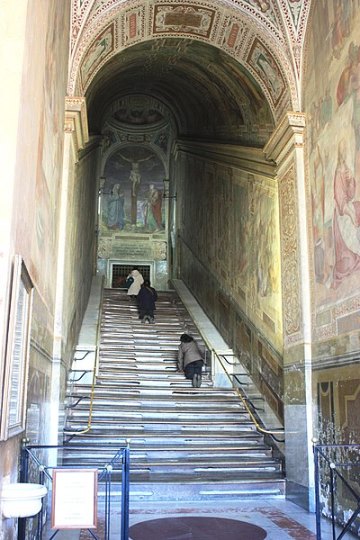
Scala Sancta (Holy Stairs)
Christians were a persecuted lot in the early centuries. But after Roman Emperor Constantine became a sympathiser of Christianity, to fulfil his own political agenda, persecutions ceased and the Roman state became the protector of the faith. Soon, the Church turned itself into a corporate body with the primary goal of amassing wealth and augmenting power. Wealth became a visible testimony to the newfound status of the church. It came to be reflected in the massive cathedrals and in the opulence of the vestments of her prelates. Along with it grew an insatiable appetite for earthly riches. The church soon turned intolerant. Pagan temples were closed, razed down or transformed into Christian shrines. Their properties were summarily added to the wealth of the Church. Jesus had commanded, “Do not store up for yourselves treasures on earth, where moths and vermin destroy, and where thieves break in and steal”, (Matthew 6:19). But the Church worked itself into a frenzy to build many heavens on this earth – the paradises of earthly opulence into which the prelates alone had exclusive access!
The Church was soon rendered the apostolic tradition of poverty a text for pious homilies to make the faithful cough up more money for maintaining the costly ecclesiastical establishment. The Church has always been innovative in creating ideas to squeeze money out of the gullible believers. One of it was the concept of pilgrimages to places that the Church had declared holy in the name of some saint or superman. With the possession of the relics of the blessed and the promotion of their fanciful legends and accounts of miracles, came the monetary offerings of the pilgrims. The more popular a shrine or a saint, the more abundant was the collection of silver and gold. Obviously, it made good business sense for the Church to declare more and more dead people as saints and to promote myths of miracles.
The Bishops of Rome, who later gave themselves the title of ‘Pope’, cultivated the myth that Peter was the first bishop of Rome and that his tomb was in the Eternal City. They claimed to be the successors of St Peter to whom Jesus had entrusted the turnkey of heaven. The cult of Peter demanded a journey to Rome to pray for favours at the tomb of St Peter. Incidentally, to this date, the church has no more plausible data than a pious tradition about the presence or martyrdom of St Peter in Rome. But the belief, eagerly propagated by the church, induced thousands of pilgrims to visit the ‘Apostle’s tomb’ to keep the cash registers of Vatican continuously ringing.
The Popes, who promoted pilgrimages to the “tomb” of St Peter, were particularly interested in enticing people who could give them costly presents, land and power. For instance, Pope Leo tells us how the Emperor Valentinian III (Western Roman Emperor from 425 to 455) and his family regularly performed their devotions at the tomb of St Peter, “such practice yielding a useful respect for the Apostle’s successors” to whom they offered costly presents and the tenure of lands. Pope Gregory even sent the nobleman Dynamius a cross containing “fillings” from St Peter’s chains, telling him to wear the cross at his throat, “which is like as if he were wearing the chains of St Peter himself.” “… these chains, which have lain across and around the neck of the most Blessed Apostle Peter, shall unloose thee forever from thy sins”, the pontiff added. Obviously, the gift of “fillings” expected a price in the form of donations to the Pope. Not content with this, Gregory began to send out “the keys of St Peter, wherein are found the precious filings and which by the same token also remit sins” – provided the recipients adequately honoured the Pope with cash or costly gifts.4
It was but natural that Christians all over the world longed to go to Rome to pray at what was supposed to be the tomb of Saint Peter. The Popes also encouraged the belief that by coming to the Eternal City, the pilgrims could address the Blessed Peter in person. A procedure was prescribed that the pilgrims had to kneel upon the tomb of St Peter, the opening to which was covered by a trap door. Then, raising the door, he had to insert his head into the hole and reveal in a loud voice the object of his visit to the saint. Of course, it is important that the devotee throw in a hefty sum as offering.
Then there is Scala Sancta (Holy Stairs) – set of 28 white marble steps. According to Roman Catholic tradition, the Holy Stairs were the steps leading up to the praetorium of Pontius Pilate in Jerusalem on which Jesus Christ stepped on his way to trial during his Passion. Medieval legends claim that Saint Helena, mother of Emperor Constantine the Great, brought the Holy Stairs from Jerusalem to Rome circa CE 326. The Scala Sancta may only be ascended on the knees. (See Picture).
In all likelihood, the “Holy Stares” was another instance of “pious fraud”. Marble was not a common building material in the Roman province of Judea. The palace was originally built by King Herod, who would not have used marble. Besides, the Romans had thoroughly destroyed Jerusalem in 70 CE. And it is highly unlikely for Helena to have located the steps some 250 years later.
The growing riches of the Church brought with it the corruption of the clergy. When Pope Gregory I was told how a priest had sold two silver chalices and two candelabra to a Jew, he issued a series of ordinances decreeing that each Christian community should make a correct inventory of all its sacred vessels, land and property. And for the first time, the church had precise information of its wealth. It owned landed property in Sicily, Gaul, Spain, the Balkan lands, the Near East and even many parts of Africa. St Peter’s Patrimony, as it began to be called, owned Syracuse and Palermo, besides numerous rich estates all over Southern Italy, Apulia, Calabria and even Gallipoli, although in ruins.The Roman Church in time of Gregory I owned twenty-three estates, whose total area comprised 380 square miles, with aggregate revenue of over one million dollars a year – a colossal sum at that point in time. It must be said that Pope Gregory I himself lived a life of austerity. But, in spite of such genuinely pious people in its leadership, the tide of corruption only gathered momentum in the Church. Consequently, 300 years after Constantine, Roman Catholicism had already turned herself into one of the biggest landowners in the West.
However, in the eighth century, when the papacy had so much that it did not even know how much, the semi-converted Slavs started to despoil St Peter’s Patrimony. Even worse, the Arabs also came to loot it, claiming that they were doing it in the name of Allah. Several papal dominions were lost. Then the Roman rulers followed suit and deprived Peter’s Patrimony of its vast estates in Sicily, Sardinia, Calabria and Corsica. Within a few decades, St Peter’s former boundless dominion was reduced to central Italy. And the Lombards (a Germanic people) of North Italy set out to grab that too. Pope Stephen II (r. 752 – 757) was horrified. He had to do something to save the Church from penury.
So, the cunning pope simply invoked the help of the Blessed Peter himself. He simply arranged for St. Peter write a letter from heaven to Pepin (Pepin the Short), King of the Franks. Of course, this celestial missive first came to the Pope. Pope Stephen sent it to king Pepin by a special papal envoy. The letter, written in pure gold on the finest vellum, began with the words: “Peter, elected Apostle by Jesus Christ. To our favourite Son, the King Pepin, to his whole army, to all the bishops, abbesses, monks, and to the whole people…”
This letter sought the intervention of the Franks to save the Romans from the Lombards in exchange of a place in heaven for King Pepin. The papal envoy personally vouched for Peter’s handwriting and signature! King Pepin wanted to know exactly how the letter had found its way from heaven to the papal office. “The Blessed Peter in person had come down from Heaven and given the letter to his successor, the pope of Rome”, said the papal envoy. French Benedictine monk and ecclesiastical writer Hugh of Fleury bluntly declares this ‘heavenly letter’ to have been nothing else than “an unexampled artifice”. But, the fraud worked. In 756, Pepin and his Frankish army forced the Lombards to surrender their conquests. But Pope Stephen II wanted the territories for himself. The Church came up with another forgery to achieve it.
This new forgery was a document called the ‘Donation of Constantine’ (Latin: Donatio Constantini). Dated March 30, 315, Donatio Constantini was a document purportedly from Emperor Constantine to Pope Sylvester I (r. 314-335). According to it, Constantine granted the pope and his successors “spiritual supremacy over the other great patriarchates and over all matters of faith and worship, and of temporal dominion over Rome, Italy and the entire western world.” According to Nicolas Cheetham, British diplomat and author, this document was “fabricated in the papal chancery during the feverish weeks when Stephen was preparing to leave for France” to meet Pepin.9
On the strength of this forgery, the pope persuaded Pepin to take Ravenna and other Italian towns from the Lombards, and restore it to the papacy since these areas belonged to it as per the forged document ‘Donation of Constantine’. The Pope was simply lying. But, in that ignorant age, the precise details about the past were not widely known beyond a limited circle of churchmen, who had monopolized the writing of the history books. No wonder we cannot know the true history of the times. The Church destroyed every record that did not suit the story it wished to propagate. (Today, it should not surprise us that Bishops and Archbishops lying with straight faces! They have been doing it right from the very start!) The forgery worked. King Pepin officially conferred upon the pope the territories belonging to Ravenna, laying the deeds and keys to the cities upon the tomb of Saint Peter. Thus, territory encompassing thousands of villages, forts, cities, farms, and estates came under the ownership of the representative of St Peter on earth – the Pope. The Donations of Pepin made the Pope for the first time a temporal ruler.
But, the more the Church acquired, the more it lusted for. And the Popes came round to the view that the newly born Papal States were too small to match the spiritual imperium of Blessed Peter. At this point, the skilfully forged document ‘Donation of Constantine’ made its official entry into the scheme of things. According to this spurious document, Constantine had handed over all the imperial garments, insignia, and symbols, including the sceptre, the lance, the orb, the standards, “et diversa ornamnta”(“and the different ornaments”) to Pope Sylvester. The Pope kept only the sceptre; this was the “ferula”, the straight staff, a straight copy of the Byzantine imperial staff whose eagle on the top was replaced with a cross – an extra-liturgical papal symbol.
This forged document makes Emperor Constantine express the wish to place the imperial crown on the head of Pope Sylvester, as a sign of true imperial power. But Pope Sylvester refused to wear the imperial crown above his clerical tonsure, whereupon Constantine put the “phrygium” (also phrigium), a conical cap worn in the Greco-Roman world, on the papal head. This “phrygium” was brilliantly white and designated the Lord’s resurrection. Constantine also gave Sylvester the imperial residence (“palatium nostrum”) as well as the city of Rome, all provinces in Italy and in the occident etc. In short, this spurious document made the emperor give all the external characteristic symbols of emperorship and sovereign control over the territories to the then Pope.
Thus, with one masterstroke, this forged document put the popes above kings, emperors and nations. The popes became the legal heirs to all lands of the planet, which the document granted to them, lock stock and barrel. No longer were the Vicars of Christ (Popes) subject to the Emperors, but the Emperors subject to the Vicars of Christ. It gave a legal basis to the territorial acquisitions of the Popes. Today historians know the truth that the so-called Donation of Constantine was a forgery, created by the Church to boost the power of the pontiffs. In 1440, Lorenzo Valla (c. 1407-1457), a Catholic priest and a courageous man, butchered this holy cow of the Roman Church. The ‘gentle’ fathers of the Inquisition tried to destroy him. Their design was thwarted by his powerful employer, Alfonso V (1396-1458), King of Aragon, whose “personal intervention saved him from the stake”.
The ‘Donation of Constantine’ was apparently forged as early as 753 and was brought by Pope Stephen II to the Court of Pepin in 754. It was instrumental in creating the Papal States. Once that was achieved, the document disappeared. It reappeared to blackmail Charlemagne, the successor of Pepin. In the year 800, Charlemagne granted additional territories to the Papal States and went to Rome to be solemnly crowned in St Peter’s by Pope Leo, as the first Emperor of the Holy Roman Empire.
The Roman Chancery produced the throne of the Blessed St Peter as well. The church asserted that St Peter sat as the bishop of Rome in that very chair! It was a further inducement to king Pepin and his successors to grant protection and more properties to the popes. And the inducement was a powerful one, since a king of the Franks, if crowned sitting on the Chair of the Turnkey of Heaven, would be invested with an authority surpassing that of any other temporal ruler, of course, with the exception of the Pope! By the following century, St Peter’s chair turned into one of the most precious relics of Roman Catholicism. Since then it has been venerated as the true chair upon which St Peter used to sit. In 1656, the chair was put inside an ornate bronze case, on papal command, by the sculptor Bernini.
Papacy was still not content. Beyond the subjugation of the Imperial Crown, it sought to control the civil administration of the whole empire. In order to achieve this goal, another forgery called, Pseudo-Isidorean Decretals (“False Decretals”), appeared some half a century later. These made its first official appearance out of the blue in 850 CE. A large portion of it was garbled, forged, distorted or entirely fabricated. The objective was to obtain additional power for the Popes by giving to the abbots, bishops, and clergy in general, authority over civil jurisdiction in all the provinces and thus establishing a legal basis for evading the orders of the secular rulers of the provinces. Thus, thanks to a series of fabrications, forgeries, and distortions, the Popes rendered themselves practically independent of all secular authority – a privilege that the clergy seeks even today.
As centuries passed, the popes continued to expand their autocratic authority. They declared that, by virtue of the Donation of Constantine, emperors were emperors simply because the popes permitted them to be so. Pope Innocent II (1198-1216), claimed temporal supremacy over all the crowns of Christendom. He claimed that as the successor of St Peter, he was simultaneously the supreme head of the true religion and the temporal sovereign of the universe. Pope Innocent IV (Pope from 1243 to 1254) asserted that what Constantine gave to the Church had not belonged to him at all, for Europe always belonged to the Church.
In an encyclical (letter from the Pope) published shortly after the close of the Council of Lyons in 1245, Pope Innocent IV expressly stated, “It is wrong to show ignorance of the origin of things and to imagine that the Apostolic See’s rule over secular matters dates only from Constantine. Before him, this power was already in the Holy See. Constantine merely resigned into the hands of the Church a power, which he used without right when he was outside her pale. Once admitted into the Church, he obtained, by the concession of the Vicar of Christ, authority, which only then became legitimate.“
The theory behind such ridiculous claims ran like this: ‘Christ is the Lord of the whole world. At his departure, he left his dominion to his representatives, Peter and his successors. Therefore, the fullness of all spiritual and temporal power and dominion, the union of all rights and privileges, lies in the hands of the pope. Every monarch, even the most powerful, possesses only so much power and territory as the Pope has transferred to him or finds good to allow him.’
Thus, the popes reigned over papal territories as absolute temporal rulers for more than a thousand years, until 1870, when the Italians, having seized Rome with all the adjacent papal territories, declared the Eternal City the capital of the newly formed United Kingdom of Italy.
———————
P.S.: This article is based on authentic sources, references to which have been left out to limit its length.
